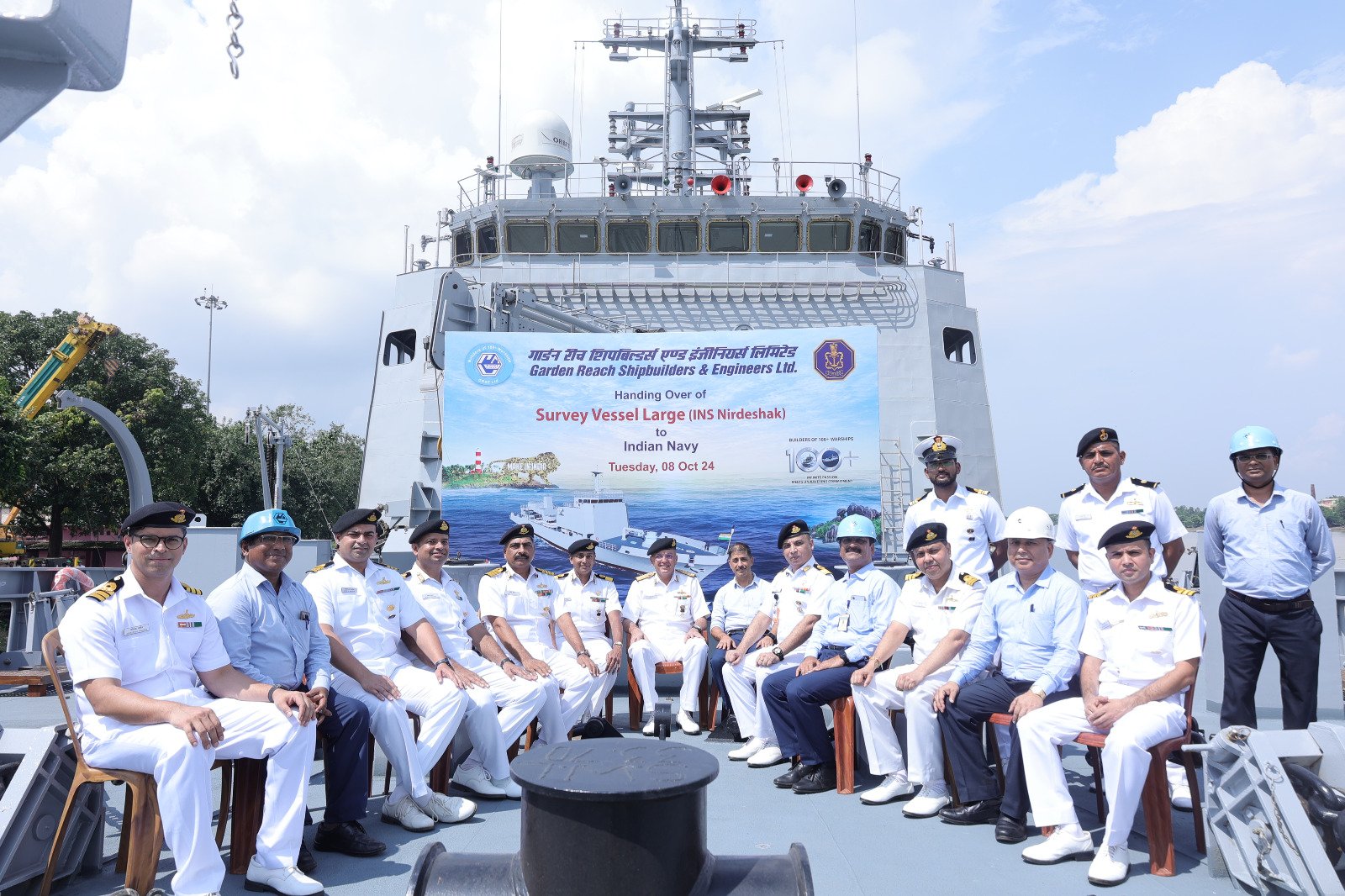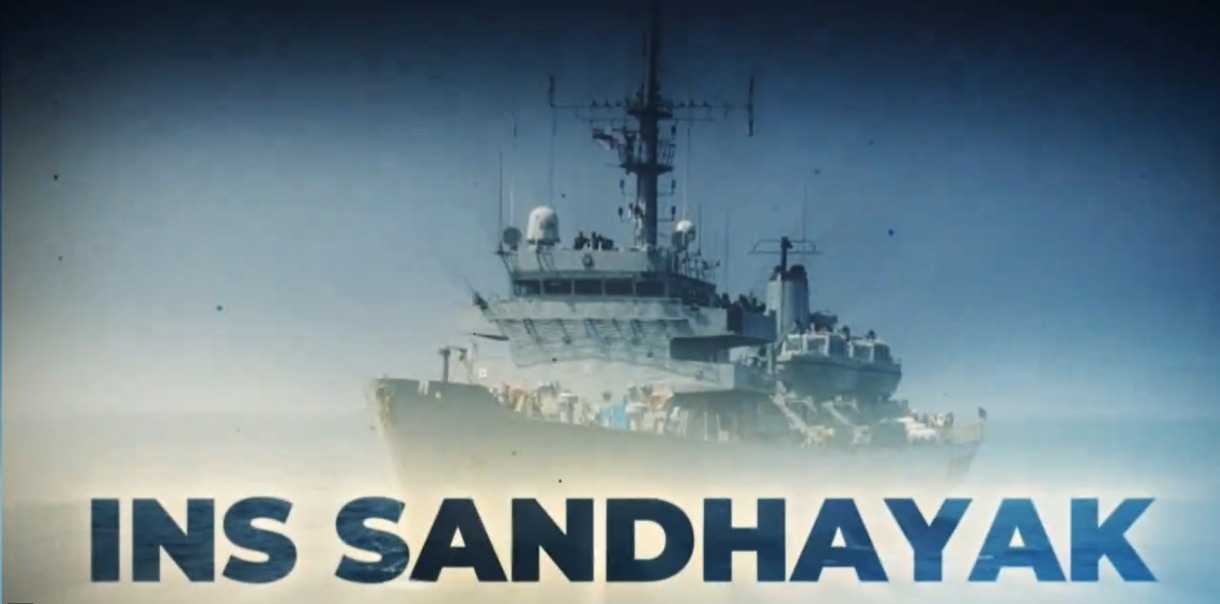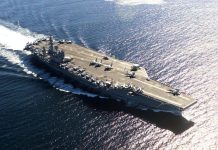Faced with a massive Chinese fleet of 64 Survey Vessels, the Indian Navy is working to build up its own capabilities. In 2024, the Indian Navy inducted its second indigenous Survey Vessel, INS Nirdeshak.
INS Nirdeshak is the second of four Survey vessels designed by the Indian Navy’s Warship Design Bureau and built by Garden Reach Shipbuilders & Engineers, Kolkata. The ship was delivered to the Indian Navy on October 8. The first ship of the class, INS Sandhayak, was commissioned on Feb 3, 2024.
The ship is capable of conducting full-scale coastal and deep-water hydrographic surveys of port and harbor approaches and determining navigational channels or routes. It will also collect oceanographic and geophysical data for defense and civil applications.
With a displacement of about 3400 tons and an overall length of 110 meters, INS Nirdeshak is fitted with state-of-the-art hydrographic equipment, such as a data acquisition and processing system, autonomous underwater vehicle, remotely operated vehicle, DGPS long-range positioning systems, digital side scan sonar, etc. Powered by two diesel engines, the ship can achieve speeds over 18 knots.
INS Nirdeshak has an indigenous content of over 80 percent by cost.
In February 2024, the Indian Navy inducted the first survey vessel, INS Sandhayak. The forces’ survey vessel by the same name was decommissioned in 2021 after four decades of service. Since then, the Indian Navy has had zero research vessels.

This is in contrast to China’s surveying capability boasted by a fleet of 64 survey vessels that have been aggressively mapping the Indian Ocean Region for unfettered submarine access.
Survey vessels are designed to examine subsea structures by sending sound waves into the ocean and collecting samples underwater. According to the International Maritime Organization’s database, 64 registered Chinese survey vessels were built in or after 1990, surpassing 44 in the US and 23 in Japan.
The importance of research vessels cannot be overstated. The older INS Sandhayak had played a significant role in Operation Pawan in Sri Lanka in 1987.
Operation Pawan was the code name of the Indian Peace Keeping Force’s (IPKF) mission to wrest control of Jaffna, the northern city of Sri Lanka, from the clutches of Tamil Tigers.
During Operation Pawan, INS Sandhayak assisted the IPKF by providing crucial hydrographic data for planning amphibious landings, ensuring safe navigation, and supporting military operations. The vessel’s hydrographic surveys helped identify suitable landing sites and assess underwater obstacles.
Mapping The Ocean
“China is aggressively pursuing the seabed mining doctrine and is much ahead of India. Also, in the South China Sea, underwater profiling is very advantageous for China for the operations of sub-surface vessels like AUVs. On the other hand, India requires more Survey vessels to have precise readings of Area of responsibility, and survey resources are usually over-stretched,” a Navy combat expert said.
Considering the Indian Navy is also working on underwater autonomous vehicles, the importance of survey vessels cannot be overstated.
In littoral warfare, precise awareness of regional waters is essential, especially for sea control. Warfare tactics for threat identification and countermeasures in the open oceans may vary from those in congested archipelagic waters. Also, to keep the marine supply lines open during hostilities, naval escorts have to ensure that cargo reaches its destination without running aground or colliding in restricted waters.
Improvements in seabed mapping are essential, especially within the EEZ. Further, dispute settlement under the United Nations Convention on the Law of the Sea (LOSC) calls for precise survey reports to establish alleged violations of sovereign rights and maritime spaces. Hydrographical surveys can also assist in locating seabed mines or detecting unexploded explosives in water.

India vs China Surveying Capability
A retired Indian Navy submariner told the EurAsian Times that the force’s lack of numbers would not impede its ability as it has a dedicated Naval Hydrographic Office in Dehradun. So far, India has been carrying out hydrographic surveys for friendly countries.
But “as India reaches out across the oceans, its requirements to carry out hydrographic surveys are bound to increase,” the officer said. The Indian Navy now uses only Indian charts for navigation, like many other countries.
The nomenclature Research Vessel could be misleading as the oceanographic research conducted by these vessels yields invaluable data that can be used by the Chinese submarines seeking to navigate the shallow waters of Malacca Strait and through the East IOR.
Unsurprisingly, India raised alarm over the activities of the Chinese research vessels in the IOR under the pretext of conducting scientific tests. New Delhi registered a sharp protest with Sri Lanka, and the island nation, understanding India’s sensitivities, has put a one-year moratorium on the Chinese vessels from docking in its ports, beginning January 1, 2024.
Answering why China maintains a fleet of over 60 survey vessels, the retired Indian Navy submariner said: “That is a good question. Maybe they are doing more than just hydrographic surveys (‘research’ vessels) and are covering a much larger area, including the Northern passage.”
In July this year, the Chinese spy ship Xiang Yang Hong 03 reached India’s strategic backyard to map the Bay of Bengal next to the scheduled Indian Navy’s surface firing exercise. After the Sri Lankan government denied docking permission, the vessel went to the Maldives to replenish fuel, food, water, and personnel rotation.
While China maintains that its activities in India’s strategic waters are benign, India is wary of them, and rightly so. The strategic community believes that despite being managed by the Third Institute of Oceanography, the ship has links to the People’s Liberation Army (PLA).
Research Vessels Mining Military Data From Ocean
Besides the ostensible scientific goals, these surveys produce data on seabed conditions that serve both civilian and military purposes. While seismic data is critical in assessing geological conditions, the presence of hydrocarbons, water, and seabed conditions also affect the ability to detect submarines.
Research vessels involved in scientific research can also use their instruments for naval reconnaissance, gathering intelligence on foreign military facilities and vessels operating in the vicinity.
By studying seasonal deployment patterns in the region, China can optimize its submarine operations. Understanding maximum depths aids in visualizing mine warfare scenarios. Continual wind data collection informs take-off and landing requirements for both enemy jets and China’s airpower in the IOR.
Reports indicate that the Chinese have been particularly interested in the Ninetyeast Ridge, a mid-ocean ridge on the Indian Ocean floor. The ridge divides the Indian Ocean into the West and East Indian Ocean.
Naval experts have contended that this range is important for submarine operations. The data will aid Chinese submarines in increasing their activity in the Indian Ocean.




